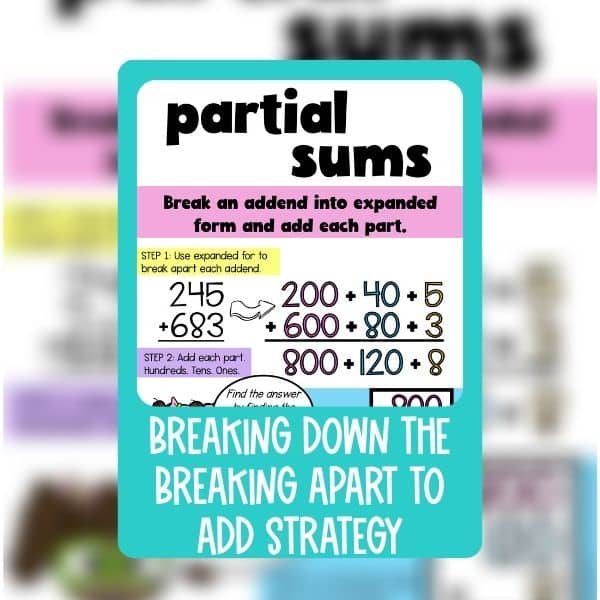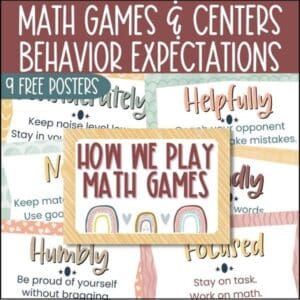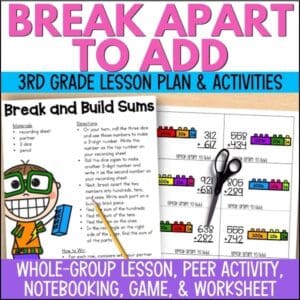Congratulations, 3rd grade math teachers! Your hard work teaching students about place value and writing numbers in expanded form is about to pay off in a big way when you move to using partial sums to add. I know you spent days and days going over what value is actually represented by numbers in each place. I mean, understanding that the 3 in the middle of 637 is really a 30 is kind of mind-blowing for 8-year-olds, but you did it!
Now it’s time to reap the rewards and get ready to watch those foundational skills shine as you turn the lesson plan pages over to addition. Put those place value skills to work with a powerful strategy called partial sums addition (AKA breaking apart to add).
Why Teach Using Partial Sums to Add?
Now it’s time for students to start adding larger numbers and learning to regroup. Adding a column and regrouping to carry tens to the next column is the end goal, but it’s a bit overwhelming to jump straight to it. Using partial sums to add is a great way to introduce regrouping by tapping into something kids already know, numbers in expanded form. But my favorite reason to teach the using partial sums to add strategy is how useful it will be in the long run for mental math. Even as an adult, it’s nice to mentally break numbers apart in my head to add them up rather than opening up the calculator app.
Let’s walk through my favorite lesson for using partial sums to add:
Review Expanded Form:
- Remind students how numbers can be decomposed into expanded form. This crucial concept lays the foundation for understanding how to break apart numbers in an addition problem, but the good news is that you’ve already taught and practiced this skill a ton.
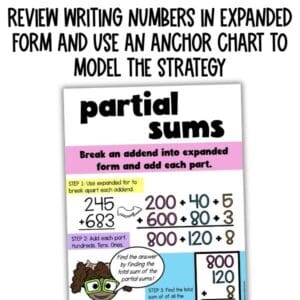
Demonstrate the Strategy:
- Show students how to break apart numbers in an addition problem into expanded form and then use those parts to create smaller, more manageable problems. For example, 123 + 456 breaks down into 100 + 400 = 500, 20 + 50 = 70, and 3 + 6 = 9. Then, find the total sum by adding 500 + 70 + 9 = 579.
Practice with Dice:
- Engage students in hands-on practice by rolling dice to generate 3-digit numbers. I don’t know why a few dice, make kids sit up and pay attention, but they do…it’s a little bit of teacher magic! Triple dice cubes are my favorite tool for generating 3-digit numbers. Allow them to practice using the partial sums strategy until they feel confident and proficient.
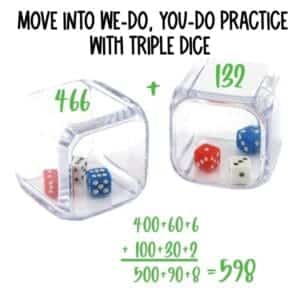
Group Activity with Cards:
- Next, I like to practice with a little cooperative learning. This allows all the kids to be actively engaged as they practice using partial sums to add and work on some SEL social skills at the same time. Print and cut apart sets of cards for each group of three students. In groups, students take turns filling different roles:
- one person chooses a card
- the next person solves the addition problem using the break apart strategy
- the final person checks the answer for accuracy
- the whole group discusses any errors as a group.

If you don’t have pre-printed addition cards, you can give each group a few dice and switch out the “choose a card” step with “roll the dice and make 3-digit numbers.”
After a little practice, I spend the rest of my math time rotating students through station and working with small groups at the teacher’s table. During stations, I make sure kids get to do these two independent activities:
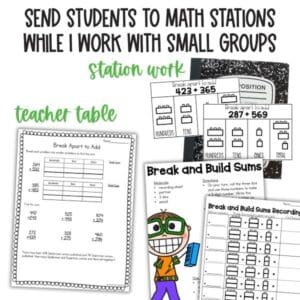
Break Apart to Add Notebook Entry:
- I love using interactive notebooks so students are always building a reference tool of strategies and skills they are learning all year long, so, of course, one of the activities is to add the the using partial sums to add strategy to their notebook. I have students cut out pieces and glue them into their notebooks as tabs. Under each tab, students write the problem created when they break apart that section of a given addition problem.
Break and Build Sums Game:
- It is very rare for a day to go by in my math classroom without a partner game. Games provide a ton of practice, offer more social skills practice, and the kids love the opportunity to play! This lego-themed game for using partial sums to add is played In pairs and I have students record all their work on a recording sheet. This keeps them accountable for doing the work, and it helps me see how well they understand the breaking apart strategy. Students roll dice to create 3-digit numbers, break them apart into hundreds, tens, and ones, and find the sums of each part. They then compare their sums to see who has the greatest number and earn points accordingly.
I know some teachers are afraid of math games because of the need for behavior management. If that’s you, I’ve got a free set of math game expectations posters will help!
When I pull students to work with me for small group instruction, I have them complete the paper and pencil assignment for the day while I watch and reteach as needed.
When it’s all said and done, students have had plenty of practice using partial sums to add, developed critical thinking skills, used collaboration, and practiced social skills as well. That’s a lot of bang for one math lesson!
Try it out and let me know what you think. Plan and teach using partial sums to add easily by grabbing the done-for-you version of this lesson.

